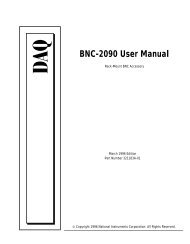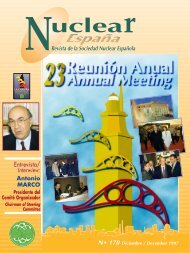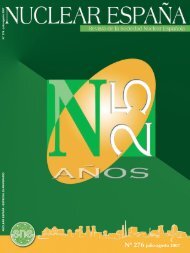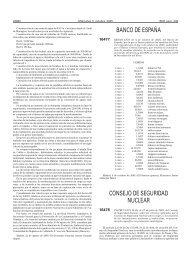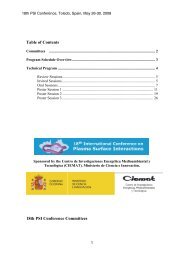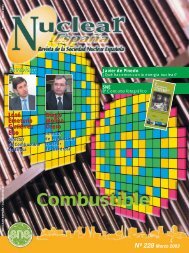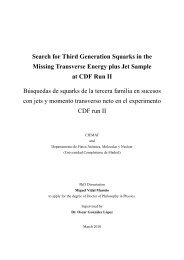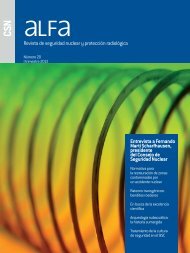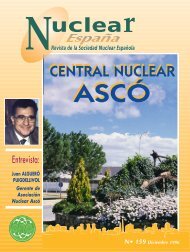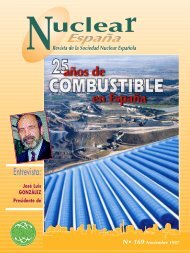EntrEntr evista/evista/ InterInter viewview
EntrEntr evista/evista/ InterInter viewview
EntrEntr evista/evista/ InterInter viewview
You also want an ePaper? Increase the reach of your titles
YUMPU automatically turns print PDFs into web optimized ePapers that Google loves.
RIAL EDITORIA<br />
Según es ya habitual por estas fechas, la Sociedad Nuclear Española celebró el<br />
pasado 2 de marzo de 2000 la Reunión anual sobre la experiencia operativa del<br />
año anterior bajo el título “Centrales Nucleares en 1999. Experiencias y<br />
Perspectivas”. El enfoque de actualidad versó sobre la experiencia nacional e<br />
internacional de la consolidación y la gestión unificada de las centrales nucleares.<br />
Por ello, junto a los asiduos oradores (el Vicepresidente-Director General de<br />
UNESA y los Jefes de las centrales nucleares españolas) estuvieron los<br />
responsables de las “Asociaciones” de las centrales de Ascó/Vandellós II y de la<br />
recientemente creada de Almaraz/Trillo. La dimensión internacional la aportó el<br />
Presidente de AmerGen (“joint venture” de la eléctrica americana PECO y la<br />
eléctrica británica British Energy), cuya ponencia tenía el sugerente título de “El<br />
renacimiento nuclear”.<br />
El año 1999 acabó en nuestro país con una producción de 58.852 millones de<br />
kWh de origen nuclear lo que representa el 28,3% del total de producción<br />
eléctrica. Esta cifra junto con unos valores del factor de carga global del 87,4%, de<br />
factor de operación del 90% y del de disponibilidad del 88,5% demuestran la<br />
tradicional buena marcha de la operación de nuestras centrales nucleares y el firme<br />
propósito de seguir en esta línea sin caer en la autocomplacencia. Como<br />
consecuencia de las actividades relacionadas con el aumento de potencia, a<br />
finales del año la potencia del parque nuclear español ascendió a 7.749,1 MW, 111<br />
MW más que el año anterior, debido a los incrementos logrados en la unidad 2 de<br />
Ascó y en Vandellós II.<br />
Con toda lógica, en un mundo en el que continuamente suenan palabras como:<br />
desregulación, globalización, competitividad, consolidación, etc., y que están<br />
conduciendo al área nuclear hacia unos esquemas de gestión más integrada y al<br />
crecimiento de las empresas especializadas en la gestión de estos activos<br />
nucleares, el pasado año nos trajo el acuerdo de las compañías propietarias de las<br />
centrales de Almaraz y Trillo para la unificación de la gestión de ambas centrales<br />
nucleares en una única Asociación de Interés Económico, con la voluntad de<br />
mantener, si no superar, la seguridad de su funcionamiento y alcanzar unos mejores<br />
resultados económicos en la explotación de las mismas.<br />
Junto a la buena nueva de la renovación de las actualmente denominadas<br />
Autorizaciones de Explotación de las centrales de José Cabrera, Santa María de<br />
Garoña y Trillo por unos períodos de 3, 10 y 5 años, respectivamente, y de la<br />
autorización del Consejo de Ministros a C.N. Trillo para la construcción del almacén<br />
de combustible gastado, el pasado año, y gracias a los trabajos preventivos<br />
realizados, el Efecto 2000 no fue más que la consolidación de una buena<br />
estructura informática de las centrales y la “excusa” de algunos para celebrar la<br />
entrada del año 2000 en su puesto de trabajo.<br />
Conviene reconocer, tras una década de constantes y excelentes resultados de<br />
nuestras centrales nucleares y de que su producción se acepta diariamente en las<br />
subastas de energía, en el mercado liberalizado del sistema eléctrico nacional, la<br />
validez de las recomendaciones del Consejo Mundial de la Energía en el sentido<br />
de que “en el futuro, las energías renovables y la energía nuclear deberán<br />
desempeñar un papel importante para reducir el mix de combustibles causantes<br />
de los gases de efecto invernadero”.<br />
No hay que olvidar que el uso de la energía nuclear, que en la Unión Europea<br />
representa el 35% de la producción de electricidad, es uno de los factores que<br />
contribuyen a no agravar la dependencia energética de otros combustibles<br />
primarios, que se ven sometidos a una fuerte incertidumbre de precios. Como se<br />
ha podido apreciar en los últimos meses con los imprevistos y significativos<br />
aumentos producidos. Tal como ha declarado recientemente la Vicepresidenta de<br />
la Comisión Europea, Loyola de Palacio, la energía nuclear desempeña un<br />
importante papel en el desarrollo en Europa de una política energética sostenible,<br />
manifestándose a favor de una postura abierta al respecto.<br />
A s is now the custom at this time of year, on March 2, 2000<br />
the Spanish Nuclear Society held its annual meeting on the operating<br />
experiences of the previous year, under the title of “Nuclear Power<br />
Plants in 1999. Experiences and Prospects”. This year’s meeting<br />
focused on national and international experiences in consolidation<br />
and unified management of nuclear power plants. Therefore, along<br />
with the regular speakers (the Vice-President and General Director of<br />
UNESA and the directors of the Spanish nuclear power plants), the<br />
heads of the “Association” of the Ascó/Vandellós II power plants and<br />
the recently created Almaraz/Trillo Association also took part. The<br />
international dimension was provided by the President of AmerGen (a<br />
joint venture of the American electric utility PECO and the British utility<br />
British Energy), whose address was suggestively titled “The Nuclear<br />
Renaissance”.<br />
In our country, the production figure at the end of 1999 was 58,852<br />
million kWh generated by nuclear, which represents 28.3% of total<br />
electric production. This figure, along with an overall load factor of<br />
87.4%, an operating factor of 90% and a capability factor of 88.5%,<br />
demonstrate the traditionally good operating performance of our<br />
nuclear power plants and the firm intention to continue on this course<br />
without succumbing to self-complacency. As a result of power uprate<br />
activities in Ascó Unit 2 and Vandellós II, the power of the Spanish<br />
nuclear park at the end of the year amounted to 7,749.1 MW, or 111<br />
MW more than the previous year.<br />
In a world in which we continuously hear words such as deregulation,<br />
globalization, competitiveness, consolidation, etc., which are driving<br />
the nuclear arena towards more integrated management schemes and<br />
the growth of enterprises specializing in the management of these<br />
nuclear assets, it was only logical that last year should bring an<br />
agreement between the owner utilities of the Almaraz and Trillo plants<br />
to merge the management of the two plants into a single economic<br />
partnership, with the will to maintain or even boost operating safety<br />
and achieve better economic results in plant operation.<br />
Along with the good news of the renewal of the Operating Permits of<br />
the José Cabrera, Santa María de Garoña and Trillo plants for 3, 10 and<br />
5 years, respectively, and the Cabinet of Ministers’ authorization to<br />
Trillo NPP to build a spent fuel storage, the preventive work<br />
undertaken last year helped turn the Y2K Effect into no more than a<br />
consolidation of a good computing structure in the plants and an<br />
“excuse” for some to celebrate the beginning of the New Year in the<br />
workplace.<br />
After a decade of consistently excellent results from our nuclear<br />
power plants and with a production that is accepted daily on the<br />
energy exchanges of the liberalized national electricity market, it is<br />
only fitting that we acknowledge the validity of the recommendations<br />
of the World Energy Board, in the sense that “in the future, the<br />
renewable energies and nuclear energy should play an important role<br />
to reduce the mix of greenhouse gas causing fuels.”<br />
We must not forget that the use of nuclear power, which in the<br />
European Union accounts for 35% of electricity production, is one of<br />
the factors that helps to curb energy dependence on other primary<br />
fuels which are subject to strong price swings, as evidenced in the<br />
last few months by significant unexpected increases. As the Vice-<br />
President of the European Commission, Loyola de Palacio, declared<br />
recently, nuclear power plays an important role in the development in<br />
Europe of a sustainable energy policy, and she is in favor of keeping<br />
an open mind in this respect.<br />
A b r i l 2 0 0 0<br />
R e v i s t a S N E




